51 Low Maintenance Shrubs for Front of House Landscaping

Low-maintenance shrubs are vital for landscaping the front of your house. Evergreen and deciduous shrubs require little care to boost curb appeal, improve security, and provide privacy. Minimal-upkeep shrubs enhance your property’s aesthetics by adding color, texture, and lush foliage to its foundation line. Low-maintenance front-of-house shrubs help make your home more welcoming without spending hours gardening.
This article explores the best low-maintenance shrubs to plant close to walls, under front windows, or at corners. You will also get top tips on choosing the best shrubs for your front-of-house landscape.
Low-Maintenance Shrubs for Front of House Landscaping
Front-of-house landscaping involves planting various evergreen and deciduous shrubs, flowering plants, and ornamental trees to create an inviting and visually appealing space. Well-planned front-of-house landscaping shrubs can increase a property’s overall attractiveness and value.
Boxwood Landscaping Shrubs (Buxus)
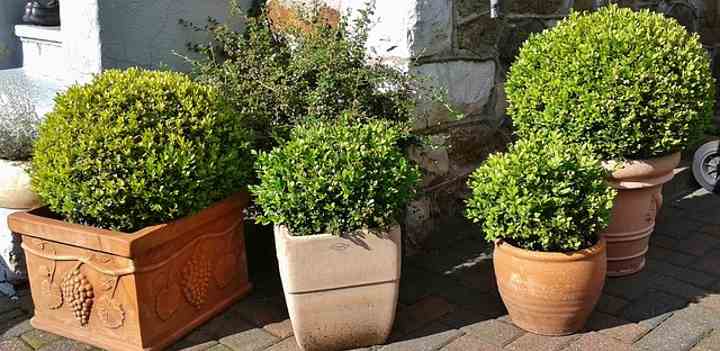
Boxwood shrubs are excellent low-maintenance landscaping plants for growing along a foundation line. The small shrubs have evergreen foliage and require little care and watering once established. Buxus shrubs have dense, compact growth habits and are easily pruned to create hedges, topiaries, and formal gardens.
Easy-care boxwoods provide year-round interest with their small, glossy leaves. You can use them in a front yard to create borders, define pathways, or add structure to a garden. Depending on the variety, boxwood landscaping shrubs can have a conical, rounded, or columnar habit. Therefore, you can plant them under a window, at the corner of a house, or to line a driveway.
Here are some common boxwood shrubs for planting in a front yard:
Dwarf English Boxwood (Buxus sempervirens ‘Suffruticosa’): This dwarf landscaping evergreen shrub has a rounded habit and grows up to 3 ft. (1 m) tall. It’s ideal for planting along a foundation or as an evergreen hedge.
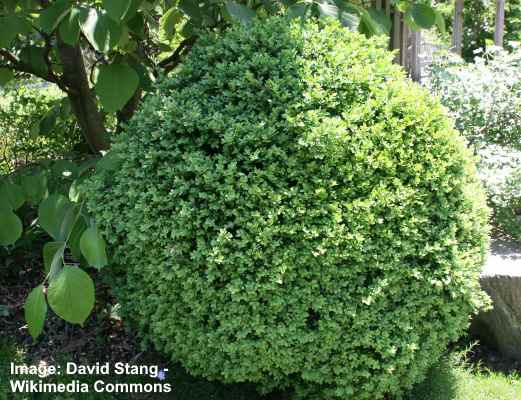
Dwarf English Boxwood (Buxus sempervirens Suffruticosa)
‘Wintergreen’ Boxwood (Buxus sinica var. insularis ‘Wintergreen’): This boxwood shrub has dense, lush foliage of bright green leaves. The shrub has a rounded shape and looks attractive along a driveway or in containers beside a front door.
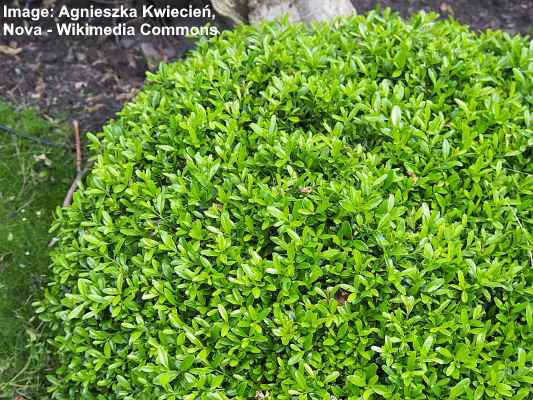
‘Wintergreen’ Boxwood (Buxus sinica var. Insularis ‘Wintergreen’)
Boxwood ‘Fastigiata’ (Buxus sempervirens ‘Fastigiata’): This upright boxwood shrub has a slender habit and looks attractive at the corner of a house. It grows 6 ft. (1.8 m) tall and 2 ft. (0.6 m) wide.
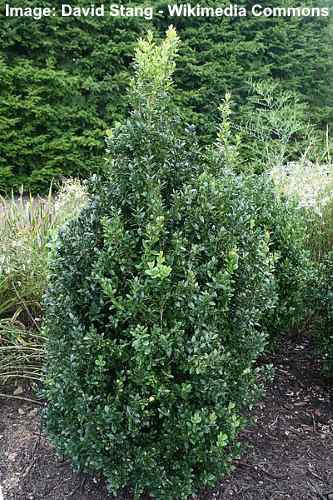
Boxwood ‘Fastigiata’ (Buxus sempervirens ‘Fastigiata’)
Variegated English Boxwood (Buxus sempervirens ‘Variegata’): The boxwood ‘Variegata’ has dark green ovate leaves with irregular creamy-white margins. The bushy shrub grows between 5 and 8 ft. (1.5 – 1.8 m) tall and wide. This boxwood is a slow-growing shrub.
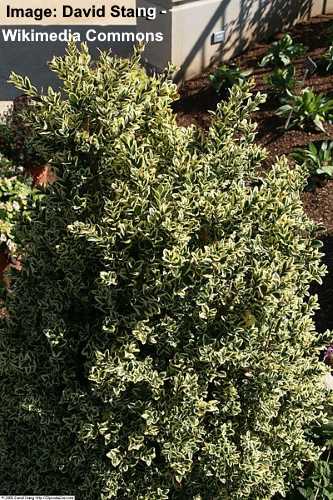
Variegated English Boxwood (Buxus sempervirens ‘Variegata’)
- USDA Growing Zone: 5 to 9
- Mature Size: Typically 1 to 6 ft. (0.3 to 1.8 m) tall and wide
- Sun Exposure: Full sun, partial shade, or deep shade
- Soil Needs: Well-drained, evenly moist soil, and most Buxus shrubs are drought-tolerant
Dwarf Cape Jasmine ‘Radicans’ (Gardenia jasminoides ‘Radicans’)

Dwarf cape Jasmine ‘Radicans’ is a stunning low-growing evergreen shrub for a front garden landscape. The shrub’s eye-catching feature is its fragrant white flowers that bloom in late spring and early summer. It’s heat and drought-tolerant and thrives in small gardens without much care.
The ‘Radicans’ dwarf cape Jasmine cultivar doesn’t grow taller than one foot (0.3 m). It’s identified by brilliant white, star-shaped flowers 1” (2.5 cm) wide, lustrous, lanceolate, glossy green leaves, and an intense, sweet fragrance. Cape Jasmine shrubs are ideal for beds and borders or planting in containers.
Other dwarf cape Jasmine varieties for front-yard landscaping include the following:
Cape Jasmine ‘Celestial Star’: The spring-blooming shrub has double white flowers and grows up to 4 ft. (1.2 m) tall—ideal as a low hedge or foundation accent.
Cape Jasmine ‘Belmont’: The medium-sized evergreen shrub has rose-like semi-double white blooms measuring 4” (10 cm) across.
Cape Jasmine’ Buttons’: This compact evergreen shrub grows 3 ft. (1 m) tall and wide and features fragrant cup-shaped white flowers.
- USDA Growing Zone: 8 to 11
- Mature Size: 1 to 3 ft. (0.3 – 1 m) tall and wide
- Sun Exposure: Full sun to partial shade
- Soil Needs: Well-draining, acidic soil rich in organic matter
Evergreen Azalea Shrubs (Rhododendron)

Flowering Azalea shrubs include small cultivars that will give stunning color to partially shaded garden
Evergreen azalea shrubs add elegance and a splash of color to front garden landscapes. The compact, flowering shrubs bloom in spring and summer with clusters of trumpet-shaped flowers. The showy, vibrant blooms appear in shades of pink, purple, red, white, yellow and orange. Evergreen azaleas thrive in partial shade.
Low-maintenance evergreen azaleas are versatile shrubs for garden landscapes. You can plant them as foundation plants, use them in borders or hedges, or grow them in containers. Here are a few examples of evergreen azaleas for front-of-house landscaping:
Formosa Azalea (Azalea indica ‘Formosa’): This azalea shrub has evergreen leaves and deep pink trumpet-shaped flowers. It grows 6 to 8 ft. (1.8 – 2.4 m) tall and wide. It is ideal for planting along a foundation line.
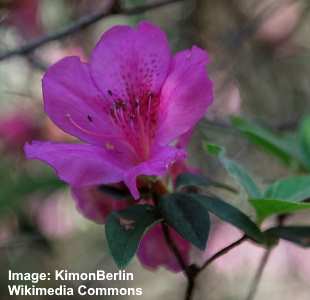
Formosa Azalea (Azalea indica ‘Formosa’)
Rhododendron Azalea ‘Autumn Sunburst’: This reblooming azalea has showy clusters of coral pink flowers with white ruffled edges—an ideal low-maintenance plant for shrub borders or an accent plant.
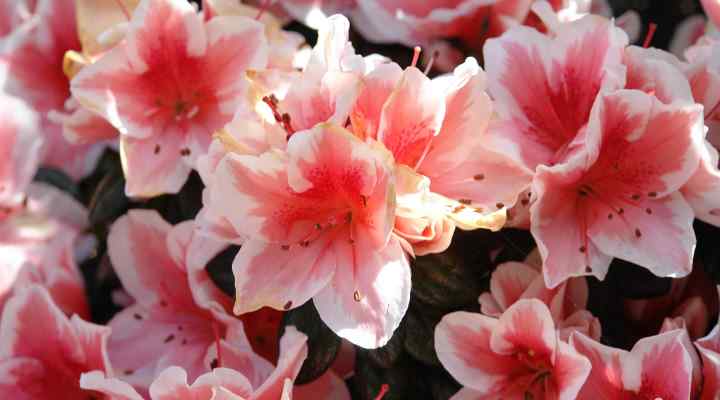
Azalea ‘Autumn Sunburst’
Rhododendron Azalea ‘Autumn Chiffon’: Known for its large pale pink flowers with dark pink speckles, this evergreen azalea grows up to 3 ft. (1 m) tall.
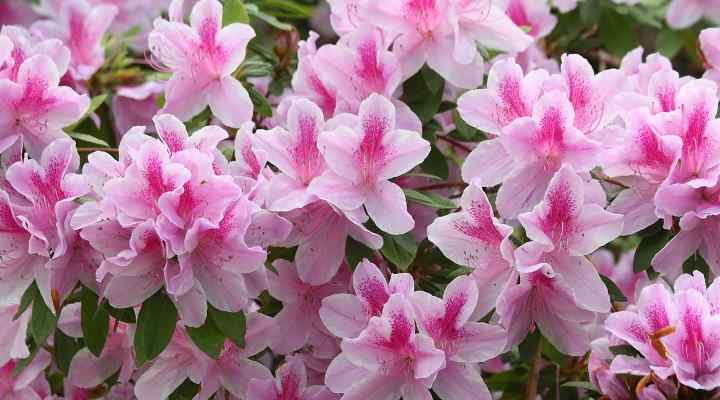
Azalea ‘Autumn Chiffon’
- USDA Growing Zone: 6 to 10
- Mature Size: 3 to 8 ft. (0.9 – 2.4 m) tall and wide
- Sun Exposure: Partial shade
- Soil Needs: Acidic, well-draining soils
Wintercreeper ‘Emerald ‘n’ Gold’ (Euonymus fortunei ‘Emerald ‘n’ Gold’)
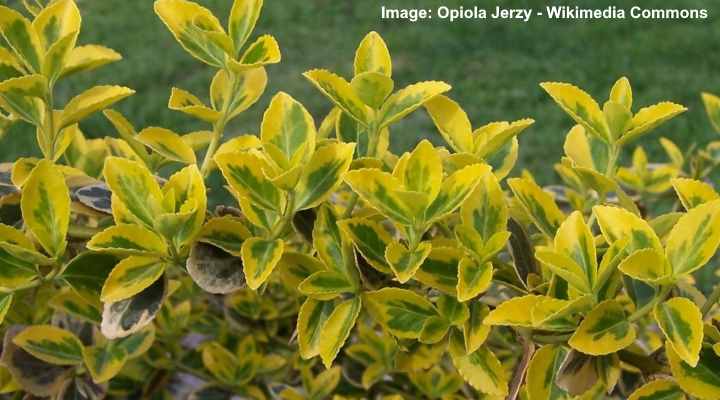
Wintercreeper ‘Emerald ‘n’ Gold’ is a versatile evergreen low-growing shrub with brightly colored yellow and green variegated leaves. Easy to care for, the spreading shrub grows 2 ft. (0.6 m) tall and 4 ft. (1.2 m) wide. In the fall and winter, the attractive yellow foliage displays hints of pink.
Wintercreeper ‘Emerald ‘n’ Gold’ is low-maintenance as it doesn’t require pruning. However, it will grow vigorously as a trailing ground cover plant, low hedge, or to brighten a foundation line. It also thrives in shaded front yards if sunlight is an issue.
- USDA Growing Zone: 5 to 9
- Mature Size: 1 to 2 ft. (0.3 to 0.6 m) tall and 3 to 4 ft. (1 to 1.2 m) wide
- Sun Exposure: Full sun, partial shade, full shade
- Soil Needs: Medium moisture, well-drained soils
Winter Daphne (Daphne odora ‘Aureomarginata’)
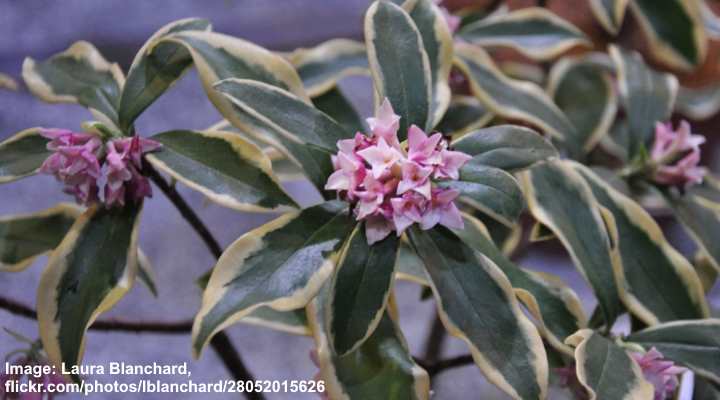
Winter Daphne is a beautiful evergreen shrub with purplish-pink flowers and doesn’t grow taller than four feet (1.2 m) in partial shade. This easy-to-care-for variegated shrub has dark green, leathery leaves with creamy margins, clusters of spring-blooming fragrant flowers, and tiny red fruits in late summer. The late winter or early spring blooms fill front yards with floral aromas.
Winter Daphne is a compact shrub, typically growing 3 to 4 ft. (1 to 1.2 m) tall and wide. Its front yard ornamental appeal makes it ideal for foundation planting, privacy hedges, or shrub borders. It’s also great for adding fragrance and color to winter front yards.
- USDA Growing Zone: 7 to 9
- Mature Size: 3 to 4 ft. (1 to 1.2 m) tall and wide
- Sun Exposure: Dappled sunlight or partial shade
- Soil Needs: Fertile, well-draining soil that is consistently moist
Inkberry ‘Shamrock’ (Ilex glabra ‘Shamrock’)
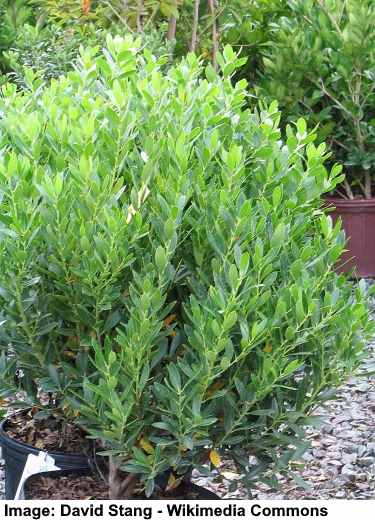
Inkberry ‘Shamrock’ is a compact evergreen shrub that looks stunning in a sunny front yard. The low-maintenance shrub is identified by its glossy, dark green leaves, masses of small, greenish-white flowers, and small black berries. The shrub’s compact growth makes it ideal for smaller front yards.
Inkberry ‘Shamrock’ has a rounded habit and dense evergreen foliage. This small shrub is resistant to deer and tolerates various soil conditions, including wet or dry soil. It performs well as a low-growing front hedge, driveway border, or foundation planting. It’s also suitable for planting in front yards that have poor drainage.
- USDA Growing Zone: 4 to 9
- Mature Size: 3 to 4 ft. (1 – 1.2 m) tall and wide
- Sun Exposure: Full sun to partial shade
- Soil Needs: Well-draining, average soil, can tolerate wet or dry conditions
Oregon Grape Holly (Mahonia aquifolium)
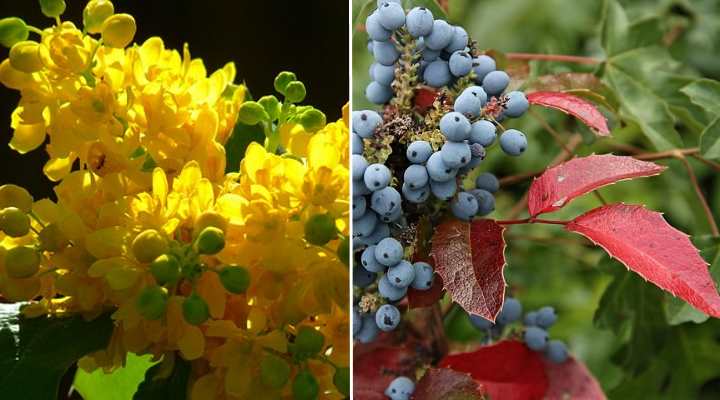
Oregon grape holly adds color and beauty to low-maintenance front yards. This native evergreen shrub has spiky, holly-like clusters of bright yellow flowers in the spring and bunches of blue-black berries with a waxy coating. The deer-resistant, drought-tolerant shrub thrives in shaded conditions in most US states.
Oregon grape holly is a versatile plant for adding year-long color to front-yard landscaping. Apart from its lush, evergreen foliage and yellow flowers, the leaves are bronze-red in spring and fall. Its compact growth and spiny leaves are ideal for foundation plantings and privacy fences.
- USDA Growing Zone: 5 to 8
- Mature Size: 3 to 6 ft. (1 – 1.8 m) tall and up to 5 ft. (1.5 m) wide
- Sun Exposure: Partial shade to full shade
- Soil Needs: Well-drained, acidic soils rich in organic matter
Indian Hawthorn (Rhaphiolepis indica)
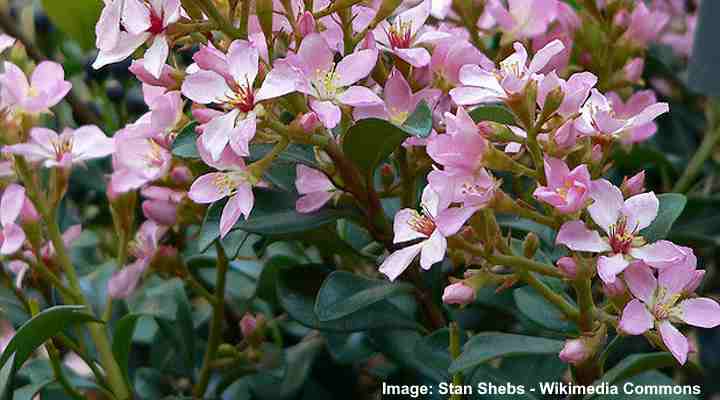
Indian Hawthorn is a type of evergreen flowering shrub with pink or white flowers. This image shows Rhaphiolepis indica cv. ‘Ballerina’
Indian hawthorn is a versatile evergreen shrub for landscaping front and backyards. Its endearing features are dense clusters of pink and white flowers, fragrant spring blossoms, leathery, oblong leaves 3” (7.5 cm) long, and dark blue berries. The shrub is also tolerant of salt spray, drought, and direct sunlight, making it a versatile, easy-care plant.
Indian hawthorn thrives in drought-prone soils in coastal regions. The ornamental evergreen shrub performs well along a front-of-house foundation line, hiding a front yard fence or decorating shrub borders. In containers, it helps to make front entrance-ways more attractive.
- USDA Growing Zone: 8 to 11
- Mature Size: 4 to 6 ft. (1.2 – 1.8 m) tall and wide
- Sun Exposure: Full sun
- Soil Needs: Well-draining, moist soils, but tolerant of drought once established
Korean Barberry (Berberis koreana)
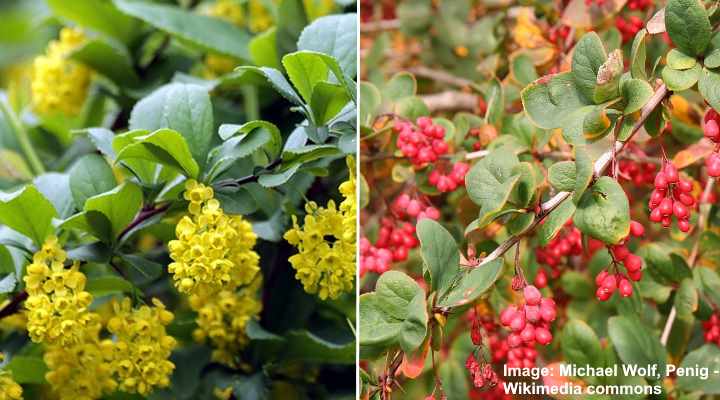
Korean barberry is a good privacy shrub for the front of the house due to its sharp spines and semi-evergreen foliage. Easy to grow in sunny or partially shaded landscapes, this thorny shrub is identified by its dangling clusters of golden-yellow flowers and elliptical green leaves 3” (7.5 cm) long. The foliage turns deep purple in the fall, adding to its ornamental value.
The Korean barberry brightens front yards in spring with its yellow flowers. These are followed by egg-shaped, bright red berries in the summer that persist until winter. The low-maintenance shrub tolerates drought, deer, and freezing conditions. You can plant it as an informal security barrier, screen, or hedge.
- USDA Growing Zone: 3 to 7
- Mature Size: 4 to 6 ft. (0.9 – 1.5 m) tall and wide
- Sun Exposure: Full sun or partial shade
- Soil Needs: Dry to moist, well-draining soil
Cavatine Dwarf Japanese Pieris (Pieris japonica ‘Cavatine’)
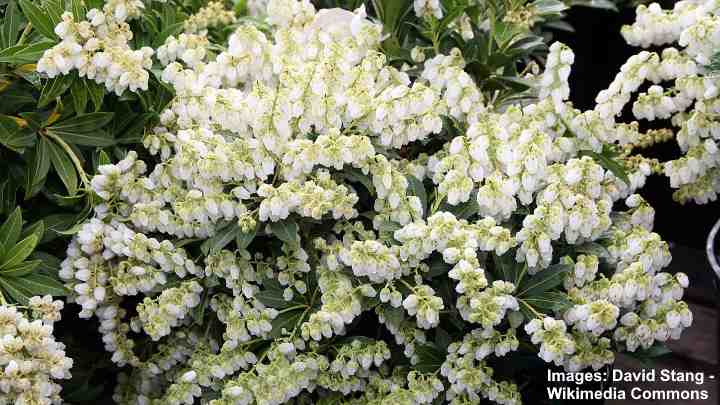
Not growing more than two feet tall (0.6 m), ‘Cavatine’ pieris is a small evergreen shrub perfect for compact front yards. The dwarf shrub is known for its lush, beautiful foliage, dense clusters of white, bell-shaped flowers, and attractive rounded shape. Thriving in dappled sunlight or partial shade, the small evergreen shrub blooms in spring.
The versatility of dwarf ‘Cavatine’ pieris as a low-maintenance shrub makes it useful for several landscaping options. The slow-growing shrub grows well as part of a shrub border, garden divider, or at the front of a foundation planting. You can also grow it in containers on either side of a front door to boost curb appeal.
- USDA Growing Zone: 5 to 8
- Mature Size: Up to 2 ft. (0.6 m) tall and 3 ft. (0.9 m) wide
- Sun Exposure: Partial shade
- Soil Needs: Acidic, well-draining soil
Chinese Privet (Ligustrum sinense ‘Sunshine’)
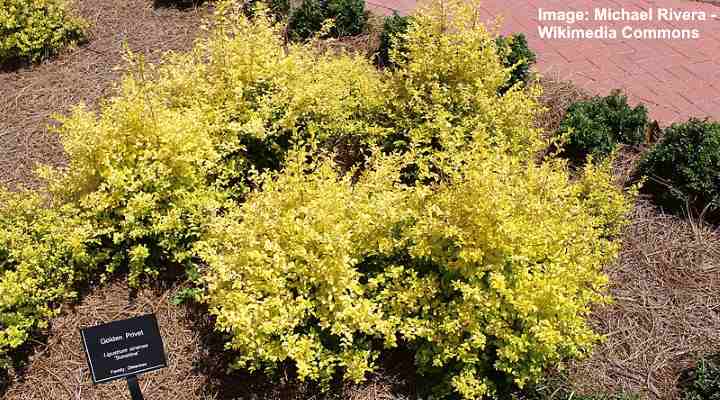
The evergreen, low-maintenance cultivar Chinese privet ‘Sunshine’ adds a splash of golden yellow colors to front yard landscaping. This stunning shrub is known for its bright golden foliage, clusters of small white flowers, and glossy bluish-black berries. The easy-care shrub is tolerant of drought, heat, and salty air.
The Chinese privet’s foliage is yellow to a vibrant chartreuse color. The small shrub is ideal for garden landscapes in USDA zones 6 and above. It adds visual interest to front yards throughout the summer. You can grow it as a colorful hedge, privacy screen, or focal point at the front of the house.
- USDA Growing Zone: 6 to 10
- Mature Size: 3 to 6 ft. (1 – 1.8 m) tall and 3 to 4 ft. (1 – 1.2 m) wide
- Sun Exposure: Full sun or partial shade
- Soil Needs: Dry to medium soils with excellent drainage
Dwarf Blooming Lilac (Syringa meyeri ‘Palibin’)
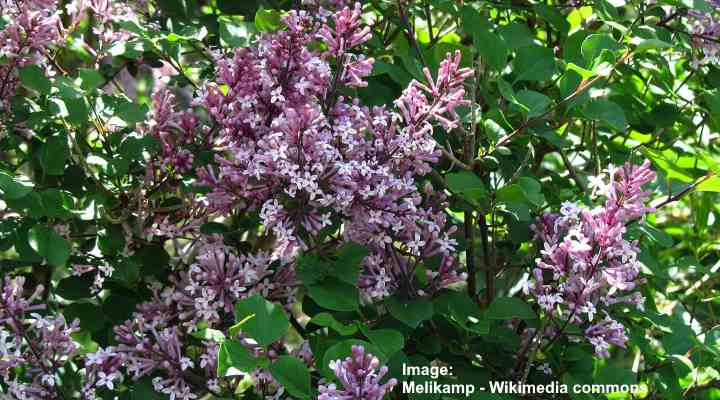
Dwarf blooming lilac is a shrub for landscaping the front of the house that doesn’t grow taller than three feet (1 m). The small lilac shrub is known for its beautiful conical clusters of star-shaped purple flowers in the spring. These blossoms contrast nicely with heart-shaped leaves. Reblooming lilacs continue to produce flowers from summer through fall.
The dwarf lilac is suitable for growing along a foundation line and under house windows. Its fragrant purple flowers add color and floral scents to garden landscapes. It doesn’t require much pruning and, therefore, is relatively low-maintenance. In addition, it thrives in most soil types, even with little rainfall.
- USDA Growing Zone: 3 to 7
- Mature Size: 2 to 3 ft. (0.6 to 1 m) tall and wide
- Sun Exposure: Full sun
- Soil Needs: Fertile, humus-rich, alkaline to neutral soil that drains well
Virginia Sweetspire (Itea virginica)
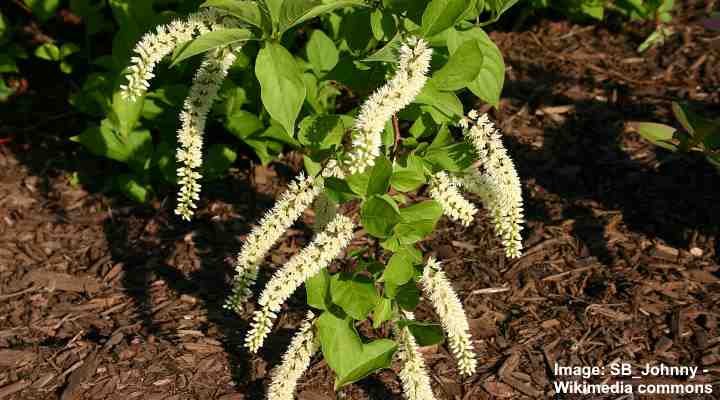
Virginia sweetspire is a deciduous, low-maintenance shrub known for its fragrant bottlebrush white flowers. Blooming in late spring or early summer, the masses of cylindrical creamy-white flower clusters cover the rich green foliage. In the fall, the leaves turn vibrant shades of red, orange, and purple, adding to its ornamental value.
Virginia sweetspire is a hardy plant that thrives in full sun or partial shade. It’s popular for informal hedges, foundation planting, or shrub borders. Its tolerance for soggy ground makes it ideal for growing in front yards with poor drainage. The sweetly fragrant flowers attract butterflies and other pollinators.
- USDA Growing Zone: 5 to 9
- Mature Size: Up to 5 ft. (1.5 m) tall and wide
- Sun Exposure: Full sun or partial shade
- Soil Needs: Moist, well-draining soil
Hydrangea Shrubs (Hydrangea macrophylla)

Hydrangea shrubs are popular flowering plants for front-of-house landscaping due to their large, colorful blooms. Bigleaf hydrangea shrubs are characterized by their mophead or lacecap pink, purple or blue flowers, elliptical leaves, and rounded, mounding form. Due to their attractive appearance and long blooming time, they make excellent foundation plants.
Other landscaping uses for hydrangea shrubs include container planting, mixed borders, or as a stunning focal point in a front yard. Hydrangeas are also popular for cut flower arrangements and dried floral displays.
Here are a few hydrangea shrubs suited to planting in a front yard landscape:
Nikko Blue Hydrangea (Hydrangea macrophylla ‘Nikko Blue’): This shrub blooms with rich blue flower clusters 5” (13 cm) in diameter. It’s a compact, low-maintenance shrub that thrives in partial shade and blooms throughout the summer. It grows up to 6 ft. (1.8 m) tall.
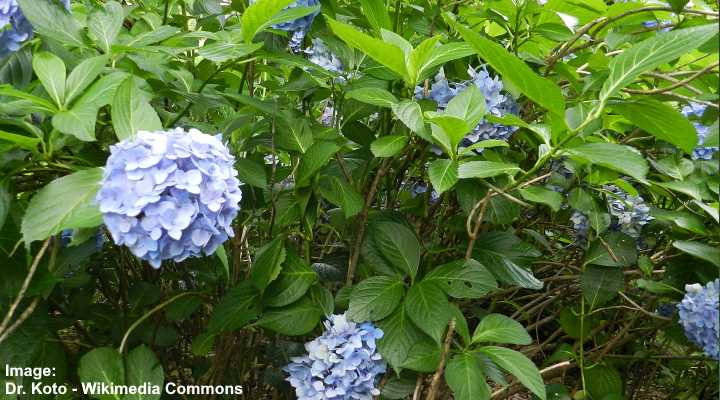
Hydrangea macrophylla ‘Nikko Blue’
Endless Summer Bloomstruck Hydrangea (Hydrangea macrophylla ‘Endless Summer Bloomstruck’): This hardy mophead hydrangea has purple, blue or pink flowers growing in large globular clusters. It grows up to 4 ft. (1.2 m) tall.
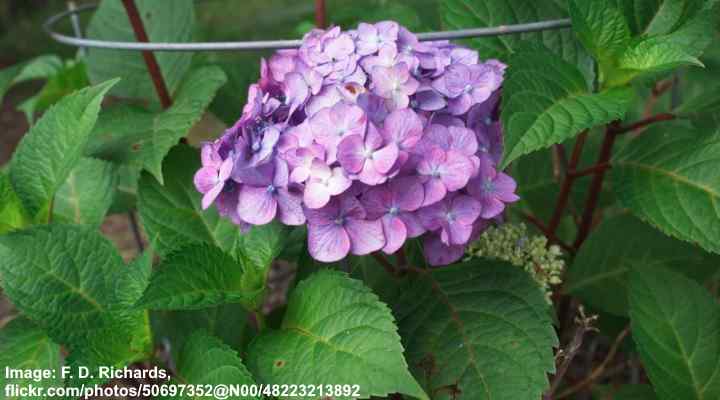
Hydrangea macrophylla ‘Endless Summer Bloomstruck’
Lacecap Hydrangea (Hydrangea macrophylla normalis): The stunning flowers consist of delicate pale pink or lavender petals surrounding a cluster of bluish ball-like florets. Easy to care for, this ornamental shrub grows up to 5 ft. (1.5 m) tall.
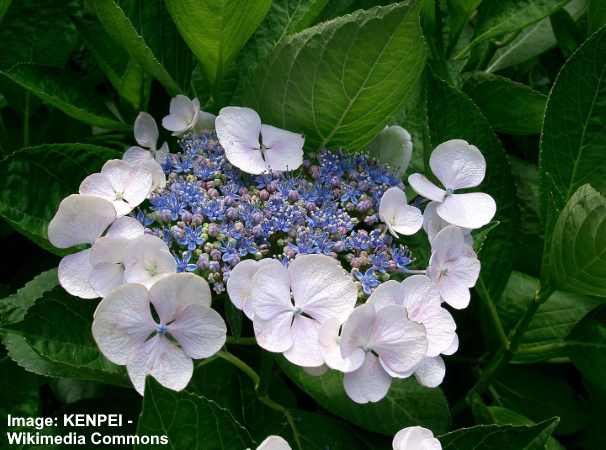
Hydrangea macrophylla normalis
Blushing Bride Hydrangea (Hydrangea macrophylla ‘Blushing Bride’): This compact, low-maintenance shrub features light pink or white flowers in a somewhat conical flowering cluster. It graces property frontage areas and only requires regular watering and occasional pruning. It grows 3 to 6 (1 – 1.8 m) tall.
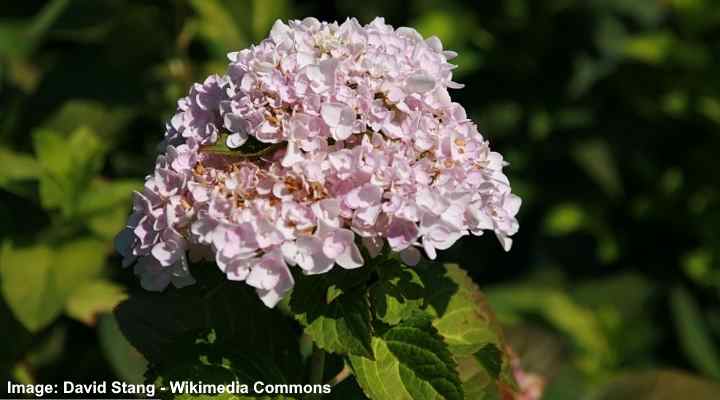
Hydrangea macrophylla ‘Blushing Bride’
Further reading: Hydrangea: Care and Growing Guide.
- USDA Growing Zone: 4 to 9
- Mature Size: Up to 6 ft. (1.8 m) tall and wide
- Sun Exposure: Partial shade
- Soil Needs: Moist, well-draining soil rich in organic matter
- Note: pH levels affect the flower colors—alkaline soil produces pink flowers, and acidic soil blue flowers
Mohave Pyracantha (Pyracantha x ‘Mohave’)
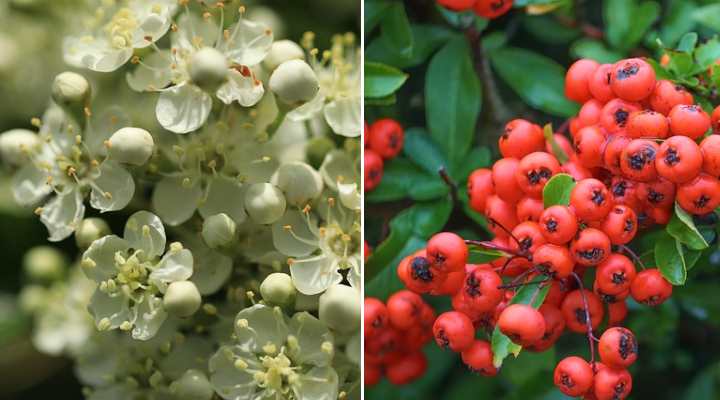
Mohave pyracantha is a versatile evergreen thorny shrub, prized for its vibrant creamy-white flowers and red berries. Thriving in full sun, the small star-shaped flowers bloom in large disk-shaped umbels. It has leathery, glossy green leaves and large reddish-orange fruits that appear in late summer, persisting until winter.
Mohave pyracantha performs well as a privacy hedge or security screen due to its dense growth habit and sharp, spiny branches. It is also drought-tolerant once established and can thrive in a variety of soil types, including clay and sandy soils.
- USDA Growing Zone: 6 to 9
- Mature Size: 8 to 10 ft. (2.4 to 3 m) tall and wide
- Sun Exposure: Full sun to partial shade
- Soil Needs: Well-draining soil, but can tolerate a variety of soil types
Evergreen Blue Holly (Ilex x meserveae)
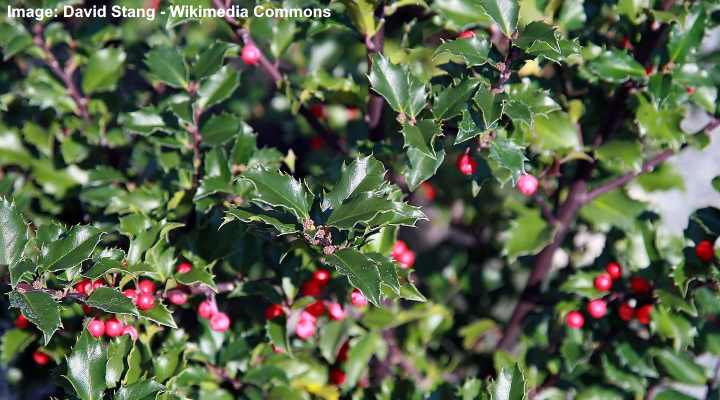
Ilex meserveae ‘Blue Princess’
Evergreen holly shrubs are popular bushy plants for adding year-round color and texture to front-of-house landscapes. For example, the blue holly has glossy, dark green leaves with spiny edges and bright red berries that persist throughout the winter. It typically has a vase shape to a rounded habit.
Ideal for front-of-house planting, the blue holly shrubs grow up to 6 ft. (1.8 m) tall. Its tolerance for salty air and drought makes it ideal for coastal landscapes. Blue holly can be planted to form a dense, impenetrable barrier, hedge, or privacy screen. They are generally low-maintenance once established.
- USDA Growing Zone: 5 to 7
- Mature Size: 3 to 6 ft. (1 – 1.8 m) tall and wide
- Sun Exposure: Full sun to partial shade
- Soil Needs: Well-drained acidic soil and can tolerate light or heavy soils
Lawson Cypress ‘Minima Aurea’ (Chamaecyparis lawsoniana ‘Minima Aurea’)
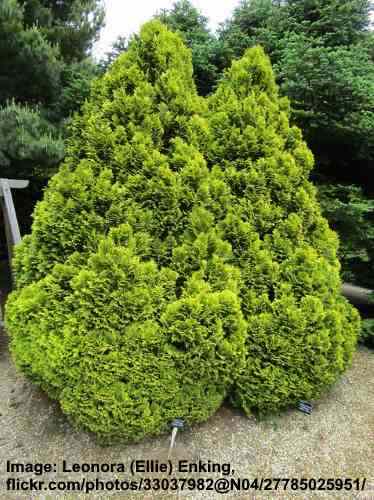
Lawson cypress ‘Minima Aurea’ is a compact evergreen shrub known for its golden-yellow foliage. This slow-growing coniferous plant has a dense, bushy, conical habit with attractive ascending flat sprays. Its brilliant yellowish-green color contrasts with other evergreen plants in a front garden.
Growing less than four feet (1.2 m) tall, the dwarf Lawson cypress is ideal for planting as a low hedge, border plant, or foundation planting. Once established, the sun-loving shrub requires little regular care to thrive, requiring minimal pruning and watering.
- USDA Growing Zone: 5 to 8
- Mature Size: 1 to 4 ft. (0.9 to 1.2 m) tall and 2 ft. (0.6 m) wide
- Sun Exposure: Full sun to partial shade
- Soil Needs: Well-drained, slightly acidic soil
American Yew (Taxus canadensis)
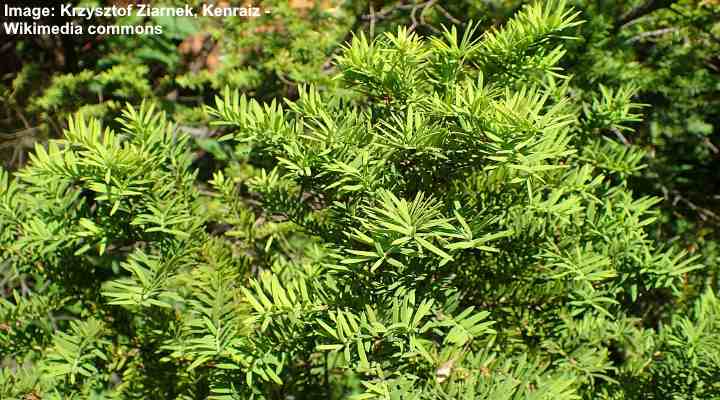
American yew is a versatile landscaping coniferous shrub with a sprawling habit, ideal for a front garden design. The small evergreen shrub has dark green needle leaves growing on ascending branches. It’s a colorful shrub in fall and winter when the foliage turns reddish-brown and vibrant, red, berry-like cones appear.
The American yew shrub is a slow-growing, easy-grow plant that tolerates shade, drought, heat, winter sun, and wind. You can grow it as a low hedge, a foundation plant, or an accent plant in a front yard. It’s also good to note that its berries, bark, and needles are poisonous.
- USDA Growing Zone: 3 to 7
- Mature Size: 3 to 5 ft. (1 to 1.5 m) tall and up to 8 ft. (2.4 m) wide
- Sun Exposure: Partial shade to full shade
- Soil Needs: humus-rich, moist, well-drained soil
American Arborvitae (Thuja occidentalis ‘Smaragd’)
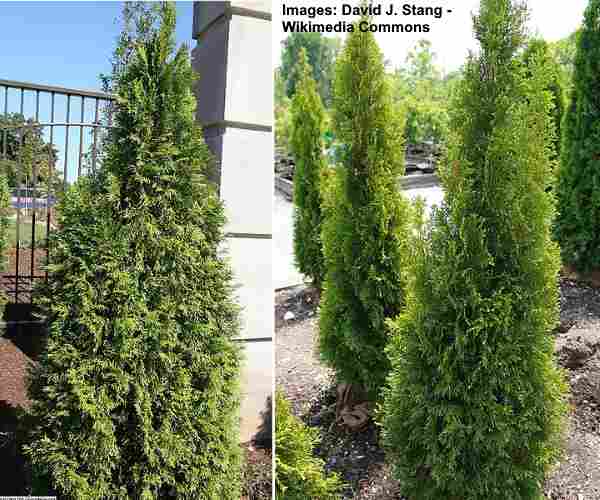
American arborvitae is one of the most popular landscaping shrubs for front-of-house planting. It’s easy to grow and performs well in cold and damp weather. The small shrubby conifer has bright green foliage, a narrow, compact habit, and a columnar shape. Its scale-like leaves are soft to the touch.
American arborvitae is a low-maintenance tree that is tolerant of a range of soil conditions. It’s a go-to choice for accenting a house corner or growing in containers beside a front entranceway. It’s also good for planting as a no-see-through hedge, screen, or foundation plant.
Further reading: Types of Arborvitae: Hedges, Trees, and Shrubs.
- USDA Growing Zone: 2 to 7
- Mature Size: Up to 14 ft. (4 m) tall and 4 ft. (1.2 m) wide
- Sun Exposure: Full sun to partial shade
- Soil Needs: Tolerant of a variety of soil conditions but prefers moist, well-drained soils
Dwarf Alberta Spruce (Picea glauca ‘Conica’)
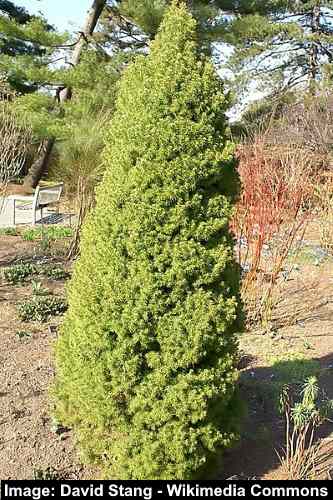
Dwarf Alberta spruce is a low-maintenance conifer that looks attractive in a front garden. The shrub’s landscaping qualities are its conical shape, dense foliage, and tolerance to cold, drought, wind, and shade. The tree’s evergreen needle foliage is vibrant green and provides year-round interest.
The slow-growing dwarf Alberta spruce doesn’t grow taller than four feet (1.2 m). Its pyramidal habit can add a focal point to a front yard landscape. It also performs well as a lawn tree or container plant to complement your front-of-house design. It’s also suitable for planting in front of the house in small, compact gardens.
- USDA Growing Zone: 3 to 6
- Mature Size: Up to 4 ft. (1.2 m) tall and 2 ft. (0.6 m) wide after ten years
- Sun Exposure: Full sun or partial shade
- Soil Needs: Most soil types with good drainage
Russian Cypress (Microbiota decussata)
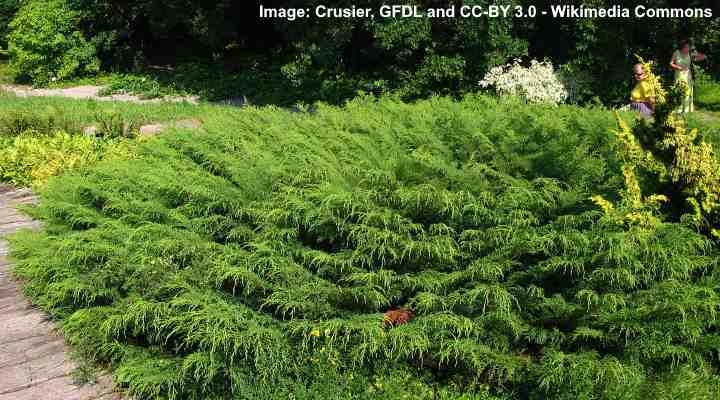
Russian cypress is a low-growing evergreen shrub, perfect for front-of-the-house landscaping in northern climates. This coniferous shrub has a dense, spreading habit and features soft, feathery, bright green foliage. The vibrant green feathery leafy sprays turn bronze-purple in the fall and winter.
Russian cypress is a hardy plant, easy to grow, and resistant to disease and pests. Unlike many cypresses, it’s tolerant of shade and survives freezing temperatures. You can plant it as ground cover for foundation plantings or shrub borders.
- USDA Growing Zone: 3 to 7
- Mature Size: 15” to 18” (15 – 45 cm) tall and up to 12 ft. (3.6 m) wide
- Sun Exposure: Full sun to partial shade
- Soil Needs: Well-draining soil, tolerant of various soil types
Skip Laurel (Prunus laurocerasus ‘Schipkaensis’)

Skip laurel is an upright evergreen shrub commonly used for hedging or screening in a front yard. The plant is identified by its glossy, dark green, narrowly lanceolate leaves, clusters of white showy flowers, and purple-black berry-like drupes. Skip laurel shrubs bloom in the spring, and their leaves remain throughout the year.
Skip laurel requires little maintenance due to its tolerance of poor soil, urban pollution, and heavy pruning. However, it requires regular watering in hot weather. It’s a great choice for creating privacy or defining boundaries in a garden or front-of-house landscape. This shrub is also deer-resistant.
- USDA Growing Zone: 5 to 9
- Mature Size: 10 to 15 ft. (3 – 4.5 m) tall and 7 ft. (2.1 m) wide
- Sun Exposure: Full sun to partial shade
- Soil Needs: Well-draining that is consistently moist
Evergreen Camellia Shrubs for front-of-house planting

Evergreen camellia shrubs are popular for front-of-house planting due to their beautiful showy flowers and glossy, dark green foliage. These shrubs bloom in white, pink, and red shades for several weeks from fall through spring. The shiny, evergreen leaves provide a lush backdrop for the beautiful flowers.
Camellia shrubs give front yards year-round interest thanks to their large, showy flowers. The flowers can be in various forms, including rose, peony, anemone, or double blooms. Dwarf camellia shrubs are ideal for screening, hedges, and foundation plantings. They also look stunning in containers at a front door or under windows.
- USDA Growing Zone: 7 to 9
- Mature Size: 4 to 10 ft. (1.2 – 3 m) tall and wide
- Sun Exposure: Full sun, partial shade, or full shade, depending on the variety
- Soil Needs: Well-drained, clay, loamy, or sandy soil
Chinese Fringe Flower (Loropetalum chinense)
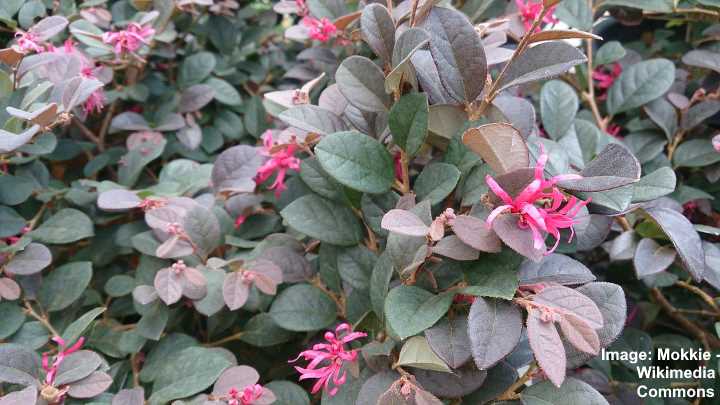
The Chinese fringe flower is a versatile shrub that adds beauty and color to a front yard. This evergreen shrub has eye-catching fringe-like flowers blooming in spring in pink or white shades. The spidery flowers contrast nicely with elliptical dark green leaves. The shrub has arching branches forming a rounded or vase shape.
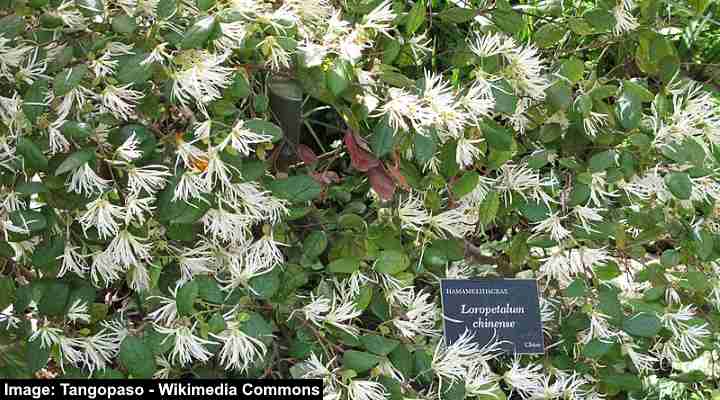
White flowering Chinese fringe flower (Loropetalum chinense ‘Emerald Snow’)
A Chinese fringe flower is a low-maintenance shrub, requiring minimal care once established. These shrubs are versatile and attractive for borders, screens, foundations, specimens, small groups, and espaliers. You can also train Chinese fringe flower shrubs to grow as a tree for a front lawn.
- USDA Growing Zone: 7 to 9
- Mature Size: 6 to 8 ft. (1.8 to 3 m) tall and wide
- Sun Exposure: Full sun or partial shade
- Soil Needs: Well-drained, organically rich soil
Viburnum Shrubs for front yard landscaping
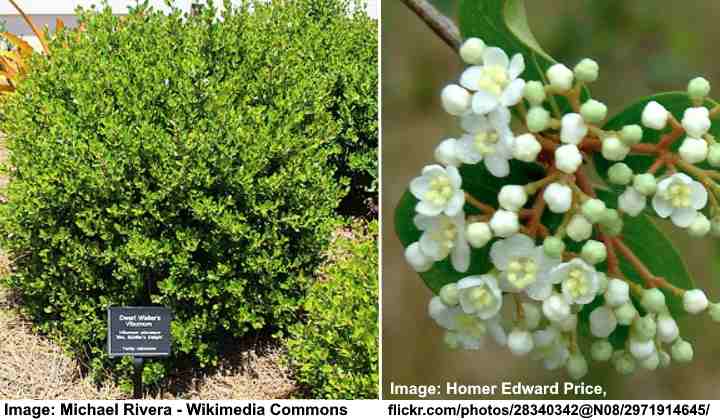
Dwarf Walter’s Viburnum obovatum (in the picture) is a perfect shrub for small, compact front gardens. It grows between 1 and 5 ft. (0.3 – 1.5 m) tall
Viburnum shrubs are popular for planting in front yard landscaping projects due to their attractive foliage and beautiful spring flowers. The woody shrubs have white or pink flowers, typically growing in flat-topped clusters. Typically, the deciduous shrubs have spectacular fall colors. You can plant viburnum shrubs as hedging or foundation plantings.
Further reading: Types of Viburnum: Shrubs, Trees and Hedges.
- USDA Growing Zone: 2 to 10
- Mature Size: 2 to 20 ft. (0.6 to 6 m) tall and up to 12 ft. (3.6 m) wide, depending on the cultivar
- Sun Exposure: Full sun, partial shade, or full shade
- Soil Needs: Well-drained, moist soils
Japanese Barberry (Berberis thunbergii)

The Japanese barberry is popular for front-of-house landscaping shrub due to its low maintenance and stunning foliage colors. The compact shrub has arching branches covered in small, oval-shaped leaves. These range in color from green to burgundy in summer and yellow, orange, or red in the fall. Clusters of tiny yellow flowers appear in spring.
Japanese barberry also produces small, bright red berries that persist throughout the winter. Its dense growth and thorny branches make it popular for foundation plantings under windows, hedges, and privacy barriers. It’s low maintenance because it tolerates various soil conditions, including drought.
Small Japanese barberry cultivars for front-yard landscaping that grow 1 – 2 feet (0.3 – 0.6 m) tall include the following:
Berberis thunbergii f. atropurpurea ‘Admiration’ has stunning red leaves with bright yellow margins.
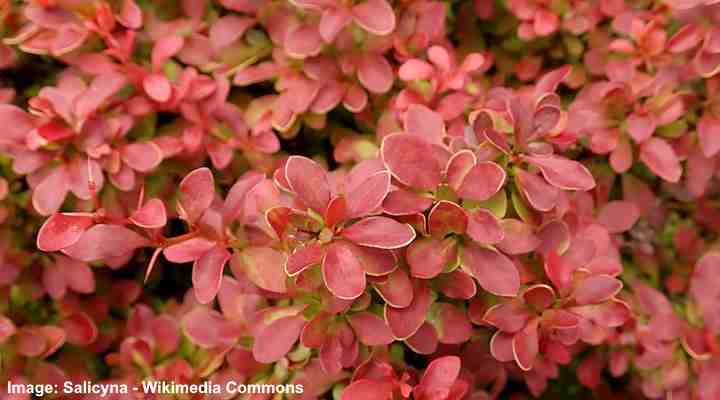
Berberis thunbergii f. atropurpurea ‘Admiration’
Berberis thunbergii ‘Atropurpurea Nana’ is a bushy shrub with reddish or purple leaves and small oval red berries.
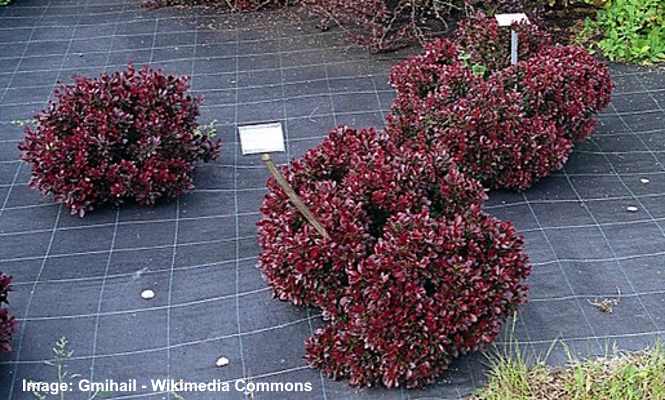
Japanese Barberry (Berberis thunbergii ‘Atropurpurea Nana’)
- USDA Growing Zone: 4 to 8
- Mature Size: 3 to 6 ft. (0.9 to 1.8 m) tall and wide. Dwarf cultivars are available too
- Sun Exposure: Full sun, partial shade, deep shade
- Soil Needs: Well-draining soil
Glossy Abelia (Abelia grandiflora) for front yard designs
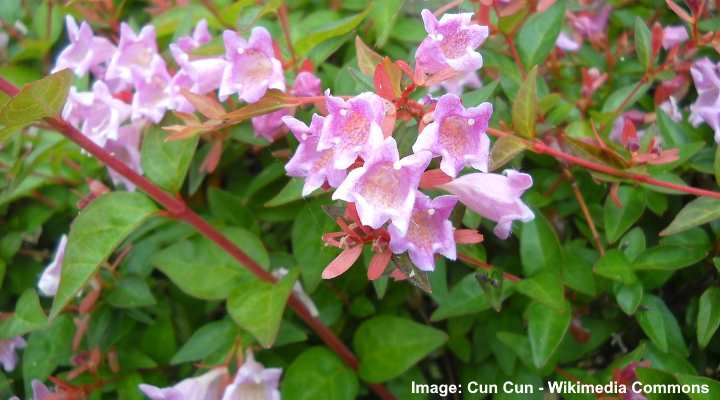
Glossy abelia blooms in late spring and summer with beautiful pink flowers that look stunning in a front yard design. This evergreen plant features glossy, dark green leaves on reddish stems and clusters of small, fragrant, bell-shaped white or pink flowers. The flowers attract butterflies and other pollinators to garden landscapes.
Other landscaping uses in a front garden include an informal hedge, shrub border, or specimen plant.
- USDA Growing Zone: 6 to 9
- Mature Size: 3 to 6 ft. (1 – 1.8 m) tall and wide
- Sun Exposure: Full sun to partial shade
- Soil Needs: Tolerant of a variety of soil conditions
Heather (Calluna vulgaris) for a front-of-house planting

Heather is a cold-hardy, low-growing shrub popular for front-of-house plantings. Characteristics of heather shrubs are beautiful flowering spikes in pink, purple, and white shades, and small dark green, evergreen leaves. Heather blooms in late summer and early fall, adding a pop of color to the front of the house when other plants may be starting to fade.
In a front garden design, heather is useful as ground cover or planted in small clusters to create a colorful border or dividing barrier.
- USDA Growing Zone: 5 to 8
- Mature Size: Up to 2 ft. (0.6 m) tall and 2 ft. (0.6 m) wide
- Sun Exposure: Full sun
- Soil Needs: Acidic, sandy, gravelly, well-draining soils
Plantain Lily (Hosta)

Plantain lilies—also called hostas—are popular shrub-like perennials for planting in shaded front yards. Hostas are known for their variety of leaf shapes, sizes, and colors. These range from shades of green to blue, yellow, and variegated patterns. Also, hostas bloom in summer, with funnel-shaped white or purple flower clusters on tall spikes.
Hostas are versatile plants for shade gardens. They are ideal landscaping solutions for creating borders, ground cover, and container gardens. They are especially useful for planting where other plants cannot grow due to a lack of sunlight.
- USDA Growing Zone: 3 to 8
- Mature Size: 1 to 2 ft. (0.3 – 0.6 m) tall and wide
- Sun Exposure: Partial shade, complete shade
- Soil Needs: Moist, fertile, well-drained soil
Japanese Skimmia (Skimmia japonica)
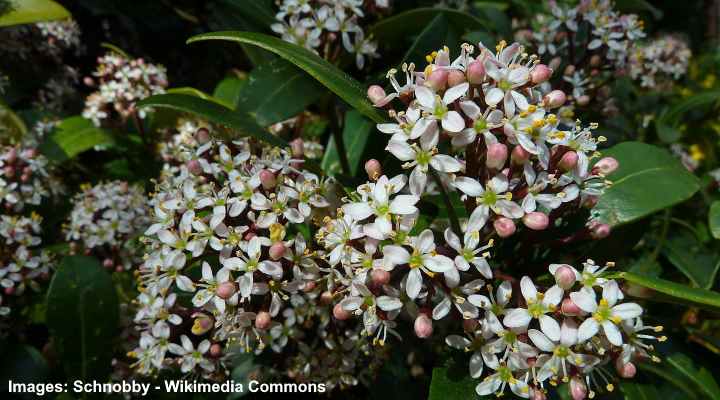
Japanese skimmia is a shade-loving evergreen shrub, ideal for sun-starved front yards. This hardy shrub has large clusters of star-shaped white flowers, glossy dark green lanceolate leaves, and masses of bright red berries. The evergreen foliage, white flowers, and red berries add a pop of color throughout the year to landscapes.
Japanese skimmia survives without much care due to its tolerance for drought, shade, and urban pollution. It performs well in shaded front yards as a foundation planting, hedge, or shrub border.
- USDA Growing Zone: 6 to 8
- Mature Size: 3 to 4 ft. (1 – 1.2 m) tall and 5 ft. (1.5 m) wide
- Sun Exposure: Partial shade or full shade
- Soil Needs: Moderately fertile, humus-rich, well-draining soil
Mock Orange (Pittosporum tobira ‘Nanum’)
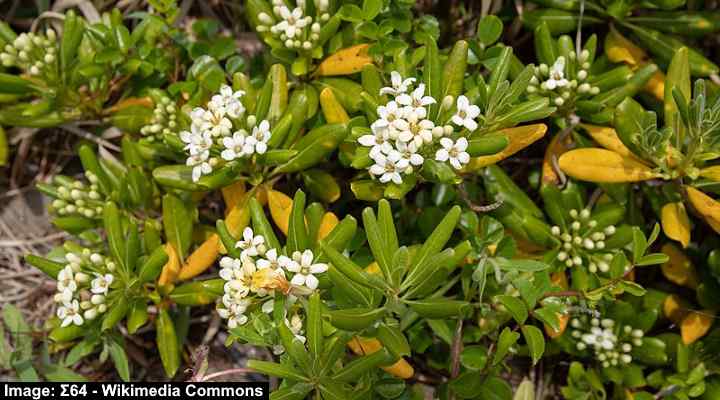
The mock orange cultivar ‘Nanum’ is a compact evergreen shrub common in sunny front yard landscapes. This easy-care shrub has dense, glossy green leaves in whorls around the stems and fragrant white flowers with orange blossom scents that bloom in late spring. It’s a fast-growing shrub, useful for various landscaping settings.
Mock orange performs well as a low formal hedge, foundation planting, or border plant. Its drought and salt spray tolerance make it an excellent landscaping solution for beach-front homes in subtropical and tropical climates.
Further reading: Types of Pittosporums (Including Variegated Pittosporums).
- USDA Growing Zone: 8 to 12
- Mature Size: 1 to 2 ft. (0.3 – 0.6 m) tall and wide
- Sun Exposure: Full sun or partial shade
- Soil Needs: Well-drained, slightly acidic, moderately fertile soils
Japanese Spirea (Spiraea japonica)
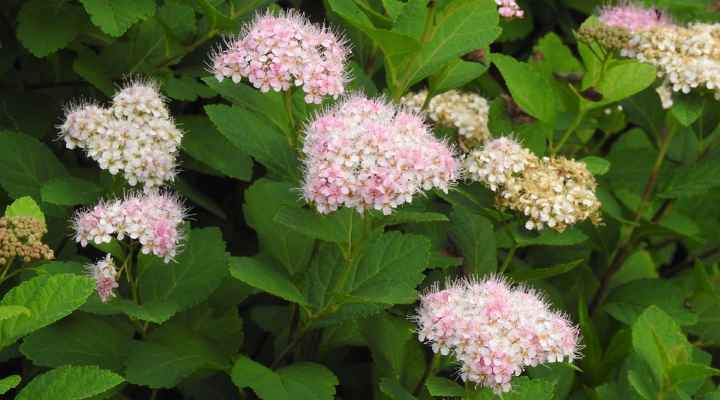
Japanese spirea is a popular shrub for adding visual interest and enhancing curb appeal in front gardens. This deciduous shrub has a rounded habit. Its identifying features are its flat-topped clusters of small, pink, or white summer flowers and serrated lanceolate green leaves. It’s a low-maintenance shrub due to its tolerance to heat and drought.
Front-of-house landscaping ideas for Japanese spirea include foundation planting, mixed borders, or creating a cottage garden. The shrub is also deer-resistant, and its fragrant blooms attract butterflies in the summer. In some areas, the shrub spreads aggressively through self-seeding and suckers.
- USDA Growing Zone: 4 to 9
- Mature Size: 4 to 6 ft. (1.2 – 1.8 m) tall and up to 7 ft. (2.1 m) wide
- Sun Exposure: Full sun or light shade
- Soil Needs: Medium moisture, well-drained soil
Dog Hobble (Leucothoe fontanesiana)
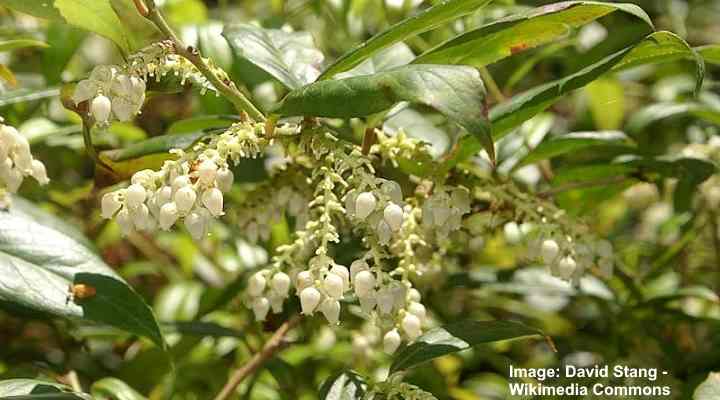
Dog hobble is a low-maintenance evergreen shrub that brightens front garden landscapes with stunning clusters of pendulous flowers. The shrub is recognized by arching, fountain-like stems, drooping bunches of urn-shaped creamy-white flowers, and attractive leaves that emerge red, turn green, and become bronze or purple in winter.
Dog hobble adds year-long interest and curb appeal to yards in constant shade. Therefore, it’s a great choice for front gardens with varying amounts of sunlight. Staying less than six feet tall (1.8 m), the shrub’s weeping effect adds grace and elegance to a property’s surroundings.
- USDA Growing Zone: 5 to 8
- Mature Size: 3 to 6 ft. (1 – 1.8 m) tall and wide
- Sun Exposure: Partial shade or full shade
- Soil Needs: Moist, well-draining, acidic soil
Bearberry Cotoneaster (Cotoneaster dammeri)

Bearberry cotoneaster is a woody, low-growing evergreen shrub useful for ground cover in front yard landscapes. This shrub has small, glossy, leathery leaves, five-petaled white flowers blooming in spring and summer, and bright red berries in the fall. The drought-tolerant shrub is ideal for partially shaded yards. It adds year-round interest to a garden at the front of the house.
The easy-grow, ground-spreading shrub works well as edging in front of a foundation planting, erosion control on slopes, or cascading over a wall.
- USDA Growing Zone: 5 to 8
- Mature Size: Up to 1 ft. (0.3 m) tall and 6 ft. (1.8 m) wide
- Sun Exposure: Full sun to partial shade
- Soil Needs: Dry to medium moisture soils that drain well
Butterfly Bush (Buddleja davidii)

The butterfly bush is a popular shrub with stunning cone-shaped clusters of fragrant flowers. Ideal for a low-maintenance front yard, the shrub blooms from summer through fall with eye-catching purple, pink, white, red, and yellow flowers. Its arching branching habit has lanceolate, gray-green leaves. Its fragrant flowers attract butterflies.
The butterfly bush is a fast-growing shrub that thrives in full sun. It’s a great addition to front yards to hide a foundation line, add color to shrub borders, or attract pollinators and hummingbirds. It’s also rabbit and deer-resistant.
Further reading: Types of Butterfly Bushes (Including Dwarf Cultivars).
- USDA Growing Zone: 5 to 9
- Mature Size: 3 to 7 ft. (1 – 2.1 m) tall and wide
- Sun Exposure: Full sun
- Soil Needs: Drought-tolerant in well-drained soils
Dwarf Fothergilla (Fothergilla gardenii)
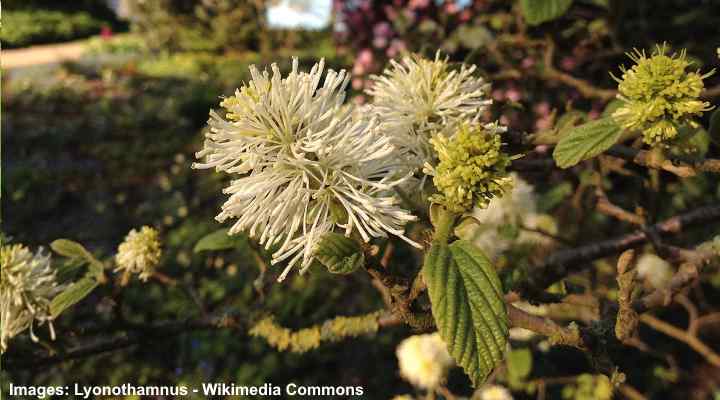
Dwarf fothergilla is a magnificent shrub with beautiful bottlebrush creamy-white flowers that brighten front gardens. This deciduous shrub has honey-scented spring-blooming flowers and attractive blue-green foliage that turns vibrant shades of orange, red, and yellow in the fall. The flowers with wiry petals measure 2” (5 cm) long.
Also called witch alder, dwarf fothergilla is an easy-grow, low-maintenance shrub. It looks attractive from spring through fall as a low hedge, foundation planting, or part of a mixed shrub border. Its tolerance for soggy ground makes it ideal for rain gardens.
- USDA Growing Zone: 5 to 8
- Mature Size: 2 to 3 ft. (0.6 – 1 m) tall and wide
- Sun Exposure: Full sun or partial shade
- Soil Needs: Moist, organically rich, well-drained soils
Wintergreen (Gaultheria procumbens)
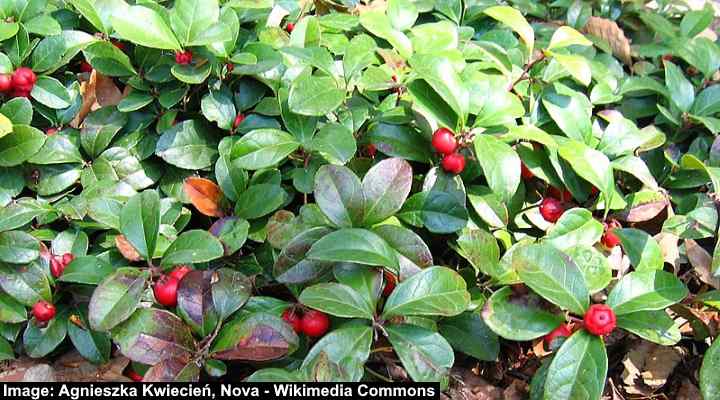
Wintergreen is easy to grow as evergreen ground cover in shaded front yards. This ground-hugging shrub is perfect for front-of-house landscapes because it doesn’t grow taller than a foot (30 cm). It features glossy, dark green leaves, and small white flowers bloom in spring. However, its most attractive landscaping feature is its bright red berries that persist throughout the winter.
Wintergreen is a hardy plant that tolerates various soil conditions, diseases, and pests. Its shade tolerance is a great solution for covering bare ground on a north-facing house front. It looks attractive throughout the year at the front of borders, covering slopes, or in containers.
In addition to its ornamental value, wintergreen has a pleasant, sweet, woody fragrance when the leaves are crushed. This feature makes it popular for planting near walkways or entrances to appreciate its fresh aromas.
- USDA Growing Zone: 3 to 9
- Sun Exposure: Partial shade or full shade
- Mature Size: 3” to 6” (7.5 – 15 cm) tall and up to 12” (30 cm) wide
- Soil Needs: Organically rich, moist, well-drained, acidic soils
Low Maintenance Shrubs for Front of House Landscaping – FAQ
How Far Should Plants Be From House foundation?
As a general guideline, it is recommended to keep shrubs that will reach 6 feet (1.8 m) or more when fully grown at least 5 feet (1.5 m) away from the house. Small shrubs can be kept 3 feet (1 m) from the house. This distance is necessary to prevent potential issues, such as damage to the foundation or interference with the structural integrity of the house.
Some plants, particularly trees or large shrubs with extensive root systems, should be placed even further away from the foundation to prevent root intrusion and potential damage to the structure. For trees or large shrubs allow a distance of 15 – 20 feet (4.5 – 6 m) from the house foundations.
What Shrubs Can be Planted Close to the House Foundation?
Shrubs that can be safely planted close to the house foundation should have slow growth rates, non-invasive root systems, and compact sizes. Examples of such shrubs include dwarf holly, azalea, and coniferous varieties.
Opt for shrubs with fibrous root systems rather than deep taproots, as they are less likely to cause damage to the foundation. Consider shrubs like azaleas, Japanese pieris, boxwood, and hydrangeas.
Select shrubs that are known for their non-invasive root systems and are considered safe to plant near structures. Spirea, barberry, potentilla, and winterberry are some excellent choices.
What are the Best Year-Round Bushes for the Front Yard?
Consider these versatile year-round bushes for your front yard: Boxwood for dense, green foliage, Japanese Pieris for delicate flowers, and the dwarf fothergilla for diverse seasonal colors. Heavenly Bamboo and dwarf yaupon holly offer low-maintenance options with bright berries and evergreen foliage. Lastly, explore the unique shapes and textures provided by dwarf conifers like Hinoki cypress and dwarf Alberta spruce.
What are the Best Evergreen Plants for the Front of House?
The best evergreen plants for the front of your house include Boxwood, which is versatile and comes in various shapes; Inkberry Holly, known for its glossy foliage and black berries; and Japanese Pieris, which offers elegant flowers and year-round interest.
Other options are the low-maintenance Dwarf Yaupon Holly, the colorful and hardy Winter Gem Boxwood, and the compact and lush Euonymus. These plants will provide your front yard with a beautiful, green appearance throughout the year.
What Plants Can Survive Without Sunlight?
Several plants can thrive without direct sunlight and are suitable for the front of the house. Hostas (Hosta spp.) are known for their attractive foliage and shade tolerance, while various fern species, including Boston ferns (Nephrolepis exaltata), can add a lush, green texture to shaded areas.
Ligularia (Ligularia spp.) is another option, appreciated for its attractive foliage and ability to thrive in moist, shady conditions. Additionally, certain begonias, like the wax begonia (Begonia semperflorens), are known for their colorful flowers and can tolerate low light.
Finally, Impatiens (Impatiens walleriana), with their vibrant blooms, can bring splashes of color to shaded areas, making them suitable for the front of the house.
What are the Best Shrubs for Screening?
When selecting shrubs for screening, consider your specific needs, growth rates, and maintenance requirements. Some effective shrubs for privacy screens include arborvitae, known for dense foliage and rapid growth; privet, ideal for creating thick barriers; boxwood, versatile for formal or informal hedges; holly, offering dense and attractive screens; Leyland cypress, providing tall and rapid privacy screens; skip laurel, known for dense growth and glossy foliage; and forsythia, offering both privacy and seasonal beauty.
Related articles:
